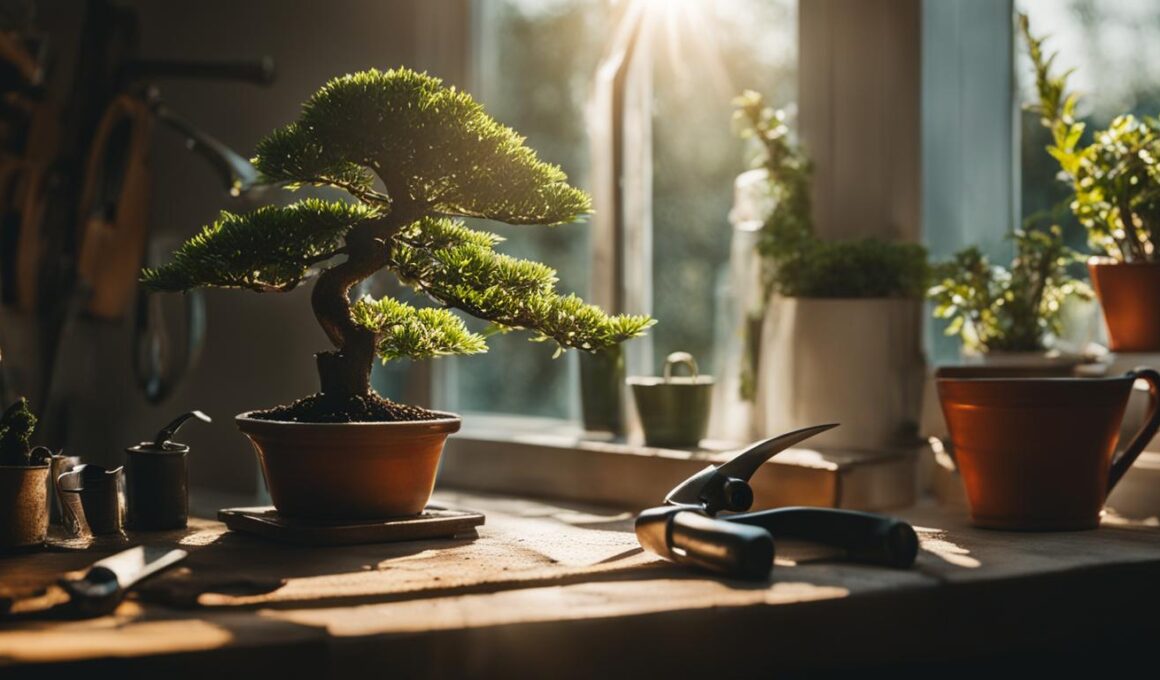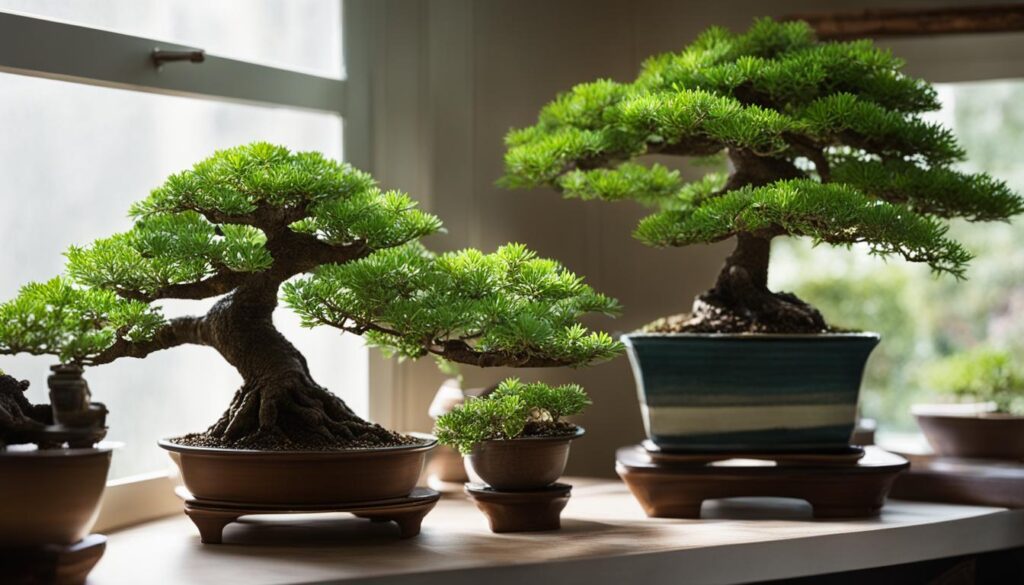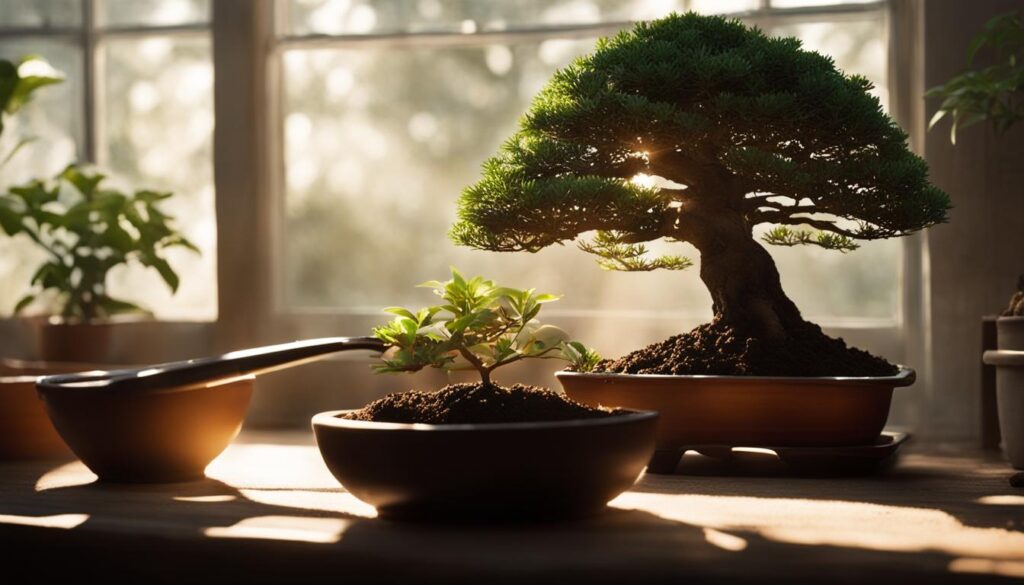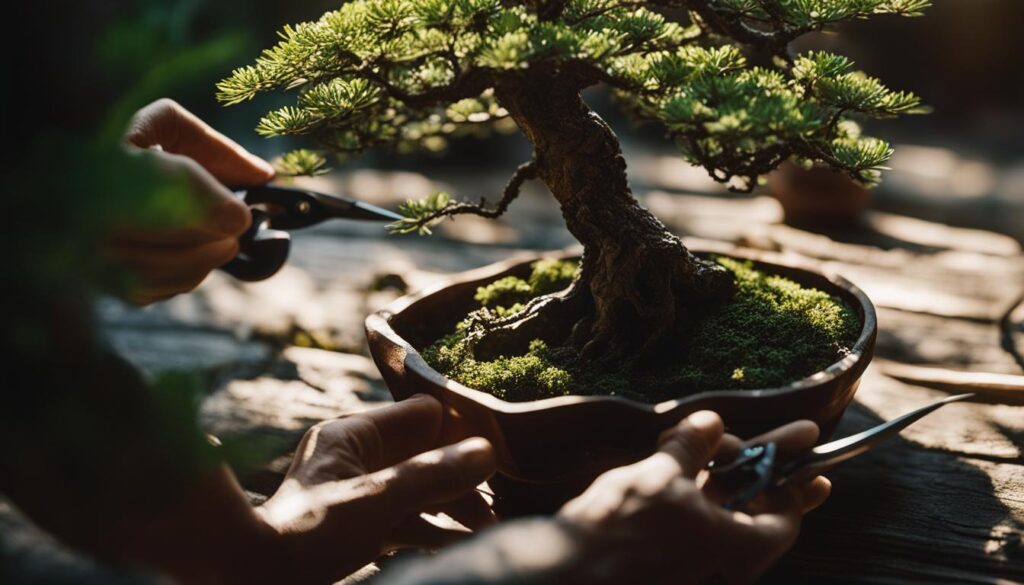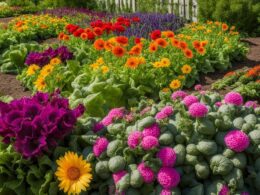Mastering the art of Bonsai care techniques is essential for a thriving miniature tree. With the right approach, your Bonsai tree can flourish under your attentive care. This guide will delve into the nuances of Bonsai tree maintenance, focusing on aspects such as proper placement, watering, and fertilization, with special attention to indoor Bonsai care. By adopting these practices, you will be well on your way to cultivating a beautiful and healthy Bonsai tree.
Key Takeaways
- Understand the difference between indoor and outdoor Bonsai care requirements
- Choose the optimal location, considering lighting and seasonal conditions
- Establish precise watering techniques based on your Bonsai tree’s specific needs
- Regularly fertilize your Bonsai with the appropriate nutrients
- Learn effective pruning and styling methods for shaping your Bonsai tree
- Consider taking online Bonsai courses or joining a community for additional support and learning
Choosing the Optimal Location for Your Bonsai
Finding the perfect spot for your Bonsai tree is crucial for its long-term health. It requires understanding the specific needs of the tree species, whether it’s an indoor or outdoor Bonsai. In this section, we’ll discuss how to select the best location for your Bonsai by determining its type and taking lighting conditions and seasonal considerations into account.
Understanding Indoor vs. Outdoor Bonsai Needs
There are two main categories of Bonsai tree species: Indoor Bonsai and Outdoor Bonsai. Tropical and subtropical trees like the Ficus and Jade are more suited for indoor care, while temperate trees such as the Japanese Maple and Juniper require outdoor conditions to experience a period of dormancy.
When determining the appropriate location, it’s essential to consider the local climate and ensure that your Bonsai’s needs correspond with the given environment. Outdoor Bonsai have varying Bonsai climate considerations, so research and understanding your specific tree species requirements are vital to its well-being.
Identifying the Best Lighting Conditions
Bonsai light requirements play a significant role in ensuring a healthy and vibrant tree. For indoor Bonsai lighting, place your tree in a bright area, preferably near a south-facing window to simulate outdoor sunlight intensity. If natural light is insufficient, consider supplementing it with artificial lighting for at least 10 hours a day. Remember that each Bonsai species has specific light requirements, so tailor your care accordingly.
Seasonal Considerations for Bonsai Placement
As the seasons change, so do the needs of your Bonsai tree. It is essential to pay close attention to the Bonsai’s environment and adjust it according to the current season.
Outdoor Bonsai trees experience a period of dormancy during winter, needed for their overall well-being. Therefore, it’s crucial to provide them with the necessary changes in temperature and humidity to ensure a healthy dormancy period.
Indoor Bonsai, on the other hand, require stable conditions close to standard room temperatures throughout the year. While they do not need a dormancy period, they benefit from consistent temperature and humidity levels.
In conclusion, proper placement for a healthy Bonsai tree depends on understanding Indoor Bonsai vs. Outdoor Bonsai needs, identifying suitable lighting conditions, and taking Bonsai seasonal care into consideration. By addressing these factors, you’ll be on track to cultivate a thriving Bonsai tree, indoors or outdoors.
Watering Bonsai: Techniques for Adequate Hydration
When it comes to maintaining a healthy Bonsai tree, proper watering techniques are essential. The key to success in Bonsai hydration is understanding that the process demands precision and due diligence, considering factors such as tree species, pot size, soil mixture, and environmental conditions. Instead of blindly following a strict watering schedule, it is crucial to assess the moisture needs of the Bonsai and water it accordingly.
- Determining the appropriate watering frequency
- Using the right watering technique
- Adjusting your Bonsai watering practices over time
To know when and how often to water your Bonsai tree, you must monitor the moisture levels of the soil. You can use your finger to feel the soil surface – if it is slightly damp, it’s time to water, but if it’s still wet, wait for the soil to dry a bit more before watering. Remember that the right frequency should be informed by factors such as the tree type, environmental conditions, and soil composition.
Proper Bonsai watering practices involve thoroughly saturating the soil until excess water drains through the drainage holes. A quality watering can with a fine nozzle can help achieve this. Gradually water the soil surface, ensuring that it is entirely soaked to reach the tree’s roots. You may need to water again after a few minutes if the soil appears to have dried out too quickly.
As seasons change and your Bonsai tree grows, its watering needs will naturally evolve. Keeping a close eye on your tree’s health and adapting your watering practices is essential to maintaining optimal hydration. For example, younger trees may require more frequent watering than mature trees, while indoor species may have different moisture requirements than outdoor varieties.
Understanding how to water Bonsai trees effectively is a vital part of their care, as improper hydration can lead to various issues, including root rot and dehydration. An attentive and knowledgeable approach to watering can help ensure that your miniature tree stays healthy and thriving.
| Tree Species | Watering Requirements |
|---|---|
| Ficus Bonsai | Keep the soil moderately moist; avoid allowing the soil to become too dry or wet. Consider humidity levels around the tree. |
| Juniper Bonsai | Water when the soil begins to dry out, ensuring that it stays slightly damp. Over-watering can cause root rot. |
| Chinese Elm Bonsai | Allow the soil surface to dry a bit between waterings. Decrease watering frequency during winter dormancy. |
| Jade Bonsai | Let the soil dry out completely between waterings. These trees can store water in their leaves, so they require less frequent watering than other species. |
Feeding Your Bonsai: Fertilization Essentials
Bonsai fertilization is an essential aspect of maintaining a healthy and vibrant tree due to the confinement of Bonsai roots in small pots. This arrangement restricts nutrient availability, making it crucial to provide a systematic approach to replenishing essential nutrients during the growing season. Choosing the best fertilizer for Bonsai depends on a variety of factors such as tree species, growth stage, and the desired outcome. In this section, we will discuss nutrient requirements, types of fertilizers, and application methods suited for Bonsai trees.
Types of Fertilizers and Nutrient Requirements
Essential Bonsai nutrients include nitrogen (N), phosphorus (P), and potassium (K), in addition to trace elements such as iron, manganese, and zinc. Fertilizers are formulated to deliver different ratios of these nutrients, catering to various growth stages and species requirements. Balanced fertilizers contain equal amounts of N, P, and K, while some formulations feature a high nitrogen content to promote growth or enhance foliage color.
Below is a table highlighting three popular types of Bonsai fertilizer:
| Type of Fertilizer | N-P-K Ratio | Typical Usage |
|---|---|---|
| Balanced | 10-10-10 or 14-14-14 | General-purpose for various species and stages |
| High Nitrogen | 10-5-5 | Encouraging growth and enhancing foliage color |
| Low Nitrogen / High Potassium | 2-10-10 | Supporting flowering and fruiting |
Organic and inorganic fertilizers have specific advantages and characteristics. Organic fertilizers, such as fish emulsion and cottonseed meal, release nutrients slowly and improve soil structure. Inorganic fertilizers, like those made from chemical compounds, provide a quicker nutrient release and are easier to control.
Before embarking on Bonsai fertilization, consider the following:
- Research specific nutrient requirements for your Bonsai species.
- Understand your tree’s natural growth cycle and fertilize accordingly.
- Consider site-specific factors such as climate and indoor conditions when selecting a fertilizer and scheduling applications.
In conclusion, providing the proper Bonsai nutrients through regular fertilization is crucial for promoting healthy growth and development. By understanding the different types of fertilizers available and tailoring them to your Bonsai tree’s specific needs, you can ensure a thriving miniature masterpiece for years to come.
Bonsai Pruning and Styling: Shaping Your Miniature Tree
Bonsai trees, being ordinary plants, are transformed into miniature living works of art through skillful training techniques such as regular pruning and wiring. Styling a Bonsai is based on precise trimming and shaping methods, not genetics, allowing for the creative shaping and cultivation of these captivating specimens. This section will discuss various Bonsai pruning techniques, Bonsai styling methods, and Bonsai tree shaping tips to help you master the art of Bonsai cultivation.
Essential Bonsai Pruning Techniques
Bonsai pruning is vital for maintaining its shape, size, and overall health. There are two primary pruning techniques applied to Bonsai trees:
- Maintenance pruning
- Structural pruning
Maintenance pruning involves trimming back new growth to control the tree’s shape and encourage branching. It is crucial to ensure the Bonsai foliage stays within the desired aesthetic proportions while promoting dense growth.
Structural pruning, on the other hand, focuses on the Bonsai’s overall design and removing or shortening branches that do not fit the desired style. This technique aims to craft a harmonious tree that is well-balanced and visually appealing.
Bonsai Styling Methods
When it comes to Bonsai styling methods, there are several classical designs to consider:
- Formal Upright (Chokkan)
- Informal Upright (Moyogi)
- Slanting (Shakan)
- Cascade (Kengai)
- Semi-Cascade (Han-Kengai)
- Group Planting (Yose-ue)
- Windswept (Fukinagashi)
These traditional styling methods are foundations for creating a uniquely attractive Bonsai tree. As a Bonsai artist, you may choose to adhere to a specific style or adapt and blend techniques to develop your personal signature.
Bonsai Tree Shaping Tips
Mastering Bonsai tree shaping involves understanding the tree’s natural form and working with it. Here are some crucial tips to guide you through the process:
- Study the tree’s growth pattern and select a style that complements its natural form.
- Begin by pruning unwanted branches and foliage, focusing on the tree’s overall structure.
- Establish the primary branches and sub-branches to create a balanced tree silhouette.
- Regularly maintain pruning and wiring to encourage the Bonsai tree to take on the desired shape.
As you develop your Bonsai tree-shaping skills through continuous practice, do not forget to tap into the vast knowledge and resources available online and from fellow Bonsai enthusiasts. Proper pruning and styling will ensure your Bonsai tree remains a healthy, thriving, and visually captivating living masterpiece.
What Care Tips Should I Follow for Indoor Bonsai Trees?
When caring for different types of indoor bonsai trees, it’s crucial to consider factors such as sunlight, watering, and pruning. Make sure to place your bonsai in a well-lit area, water it regularly but not excessively, and trim it to maintain its desired shape.
Conclusion
Proper Bonsai care is a fundamental aspect of ensuring the health and longevity of your miniature tree. By following Bonsai maintenance tips, such as providing the appropriate location, mindful watering, consistent fertilization, and suitable styling, you can achieve successful Bonsai cultivation. It is essential to adapt these practices to meet the specific needs of your Bonsai species and its environment.
Key Takeaways for Successful Bonsai Care
Successful Bonsai care involves a combination of understanding your tree’s requirements, monitoring its health, and implementing the appropriate care techniques. It is crucial to be proactive in your Bonsai’s maintenance, as this living art form requires consistent attention to thrive. Remember to be patient, as Bonsai cultivation is a rewarding, lifelong learning process.
Continuing Your Bonsai Education and Resources
Investing in Bonsai education can significantly improve your ability to care for and appreciate your miniature tree. Online resources, such as video tutorials and forums, can provide valuable information and insights. Connecting with other Bonsai enthusiasts, local clubs, and shops can offer additional support and contribute to your ongoing learning experience. Keep an open mind and continue to explore new concepts and techniques to refine your Bonsai care skills and ensure your tree’s well-being.





